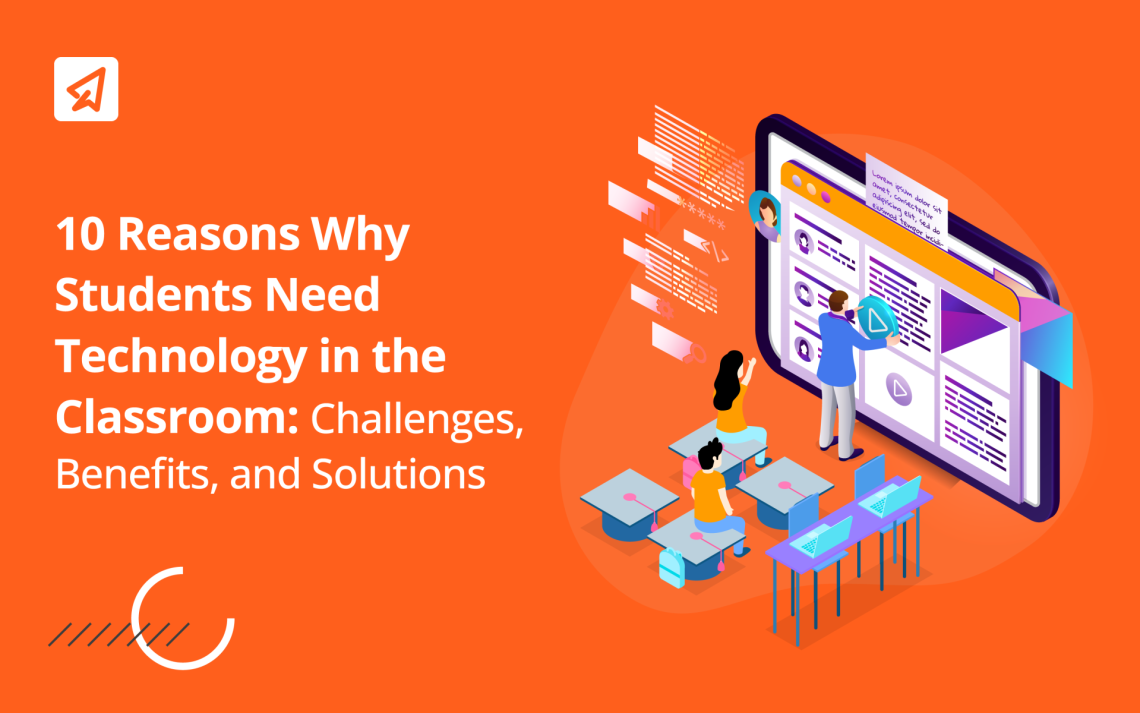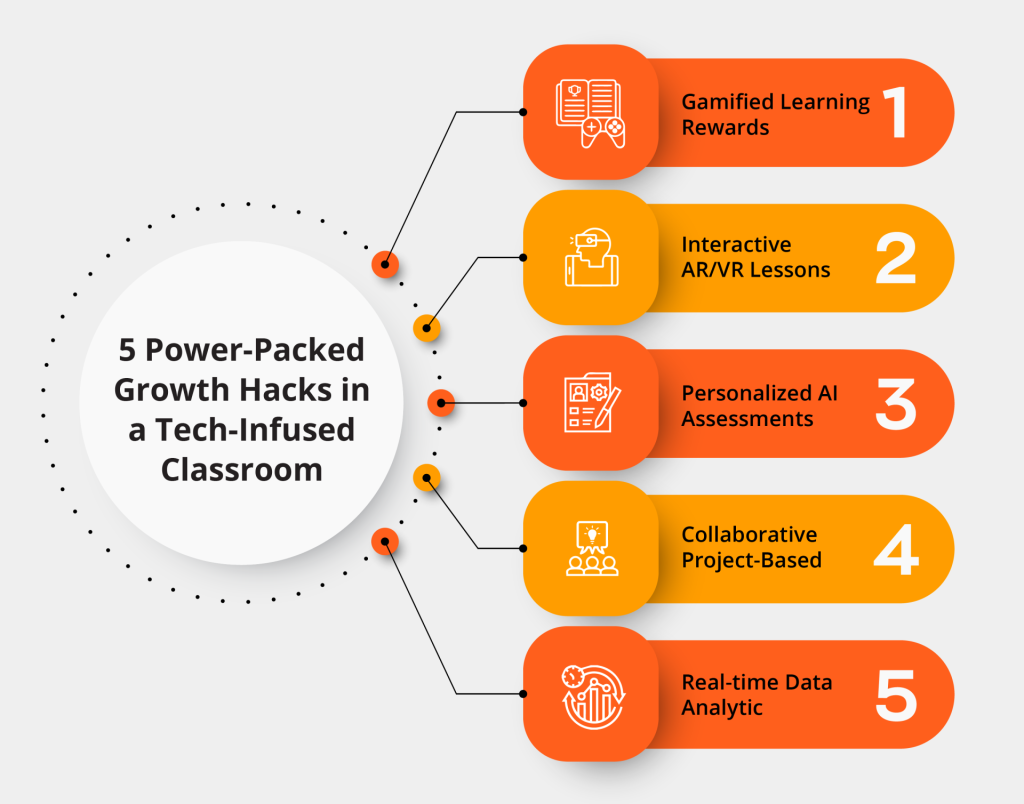10 Reasons Why Students Need Technology in the Classroom: Challenges, Benefits, and Solutions

Technology in the classroom has become an essential tool for you dear learners, enhancing your learning experience through interactive learning, engagement, collaboration, and access to information. It prepares you for the digital world, equipping them with technological skills, fostering digital citizenship, and promoting adaptability. Personalized learning addresses individual pace, content customization, and learning styles. Digital literacy improves through research, media literacy, critical thinking, and problem-solving. Additionally, technology boosts engagement, facilitates collaborative learning, prepares you for future careers, overcomes educational barriers, enhances creativity and innovation, ensures access for you, and tackles technological challenges. Let’s explore the reasons why you need technology in classrooms!
#Reason1: Enhancing Learning Experience
With technology, learning becomes a whole lot more interactive and engaging. No more boring lectures where you’re just trying to stay awake. Technology brings the classroom to life, with immersive experiences and interactive learning activities. It’s like stepping into a virtual dream where equations come alive and historical figures appear on the screen.
But wait, there’s more! Technology also fosters collaboration and engagement among you and your classmates. With technology, everyone gets a chance to participate and contribute. Plus, it’s always more fun to learn with a little friendly competition, right? One such tool is Extramarks Smartclass Plus, which helps you learn in an interactive and fun way.
And let’s not forget about multimedia presentations. Gone are the days of boring slide shows and blackboard scribbles. With technology, you can create visually stunning presentations with videos, images, and interactive elements.
Access to information is also a game-changer. You are no more relying solely on textbooks. With technology, you can access information from around the globe with just a few clicks. Need to know about the Pyramids of Egypt? Boom, there’s a virtual tour waiting for you.
So there you have it, just a taste of how technology can transform the learning experience.
#Reason2: Preparing for the Digital World
Technology is not just a passing fad; it is here to stay. And that means you need to be prepared for the digital world that awaits you. One needs technological skills to navigate digital platforms, use online tools, and understand basic programming concepts. In a world that is becoming increasingly digital, these skills are very important.
There’s also this thing called Digital citizenship which is all about using technology responsibly and ethically. It’s about being aware of the impact your online actions can have on others and being able to navigate the digital world without falling into any Internet traps.
And let’s not forget about adapting to change. In today’s fast-paced world, technology is constantly evolving. What was cutting-edge yesterday is old news today. And if you want to keep up, you need to be able to adapt to these changes. Because if you can’t adapt, you’re going to be left in the digital dust.
You need technology in the classroom to prepare for the digital world. Whether it’s gaining technological skills, understanding digital citizenship, or adapting to change, technology is essential for their future success.
#Reason3: Personalized Learning
This approach to learning allows you to follow your own pace and explore topics that truly interest you. No more being dragged along by the slowest kid in class or forced to study subjects that make you want to gouge your eyes out.
The individual pace is the name of the game here. You can move ahead if you’re a quick learner, or take a bit more time if you need it. No more being held back by the average speed of the class or feeling lost because the teacher has zoomed through the material faster than a cheetah.
But it’s not just about speed, Personalized learning also means customized content. Imagine a world where the curriculum is tailored to suit your interests, your strengths, and your learning style.
And speaking of learning styles, personalized learning also addresses different ways of learning. Whether you’re a visual learner, an auditory learner, or a kinesthetic learner, this approach takes it all into account. It’s like having a buffet of learning strategies at your disposal, allowing you to choose the ones that work best for you.
Personalized learning is all about setting your own pace, diving into customized content, and addressing your unique learning style. It’s like having the perfect learning experience tailored just for you.
#Reason4: Improving Digital Literacy
Technology in the classrooms is also about improving digital literacy and equipping you with the skills you need to navigate the ever-changing digital landscape. So, let’s take a look at how technology can enhance your ability to research, think critically, and solve problems.
First and foremost, technology provides you with the tools you need to become research ninjas. With just a few clicks, you can access a vast amount of information from reliable sources. You can develop your research and information literacy skills by learning how to sift through the vast amount of information available online and how to critically evaluate its credibility.
But it’s not just about research skills; technology also enhances your media literacy. With the rise of fake news and an endless stream of information surrounding us from all directions, it’s crucial for you to learn how to critically analyze media messages. You can learn to question the motives behind the information you encounter and develop a healthy skepticism for sensationalist headlines.
Furthermore, technology promotes critical thinking and problem-solving skills. You can engage in interactive learning experiences that require you to think creatively and find innovative solutions. You can use online platforms to collaborate with your friends and develop your critical thinking skills through discussions and debates.
#Reason5: Increasing Student Engagement
Gamification is the name of the game, quite literally when it comes to the increase in student engagement. By incorporating game elements into the learning process, we can turn education into an exciting adventure.
Interactive apps and tools take learning to a whole new level. No longer you are a passive recipient of knowledge. You have become active participants, exploring, experimenting, and interacting with educational content. From virtual reality simulations to online quizzes, there’s a world of possibilities at your fingertips.
And let’s not forget about those real-world connections. We all know that dreaded question: “When am I ever going to use this in real life?” Well, with technology, we can bridge the gap between your classroom and the real world. You can connect with professionals in your fields of interest, collaborate on projects with peers from different parts of the globe, and gain valuable insights from experts through video conferences.
#Reason6: Preparing for Future Careers
In today’s rapidly evolving world, it is imperative for you to be prepared for the future job market. And what better way to equip yourself than by integrating technology into the classroom?
One key advantage of technology integration in the workplace is its ability to foster digital communication. In the digital age, effective communication is crucial, whether it’s between colleagues or clients. By using technology in the classroom, you can develop your communication skills through online collaboration tools, video conferencing, and email communication.
Additionally, technology helps you develop problem-solving and adaptability skills. The workplace of the future will require individuals who can think critically and come up with innovative solutions to complex problems. By incorporating technology into your learning experiences, you can engage in hands-on problem-solving activities, coding projects, and design thinking exercises. This not only enhances your ability to think outside the box but also equips you with valuable skills that will set them apart from your peers.
Moreover, technology integration in the classroom prepares you for the rapidly changing nature of the modern workforce. With new technologies emerging every day, it is crucial for you to be adaptable and open to learning new skills. By incorporating technology into your education, you can become comfortable with using various tools and software, making it easier for you to transition into different roles and industries in the future.
#Reason7: Overcoming Educational Barriers
Technology has become an integral part of education, breaking down barriers and opening up new opportunities for students. One of the areas where technology is making a significant impact is in overcoming educational barriers.
Distance learning has become increasingly popular, allowing you to access education from anywhere in the world. No longer limited by geographical boundaries, you can now pursue your education without having to physically be present in a traditional classroom setting. This is especially beneficial for those who are unable to commute to school due to various reasons.
Special education support is another area where technology is making a difference. With the help of assistive technology, students with special needs can receive the personalized support they require. Whether it’s through speech recognition software, braille devices, or text-to-speech tools, technology is leveling the playing field and ensuring that all students have an equal opportunity to learn and succeed.
#Reason8: Enhancing Creativity and Innovation
With technology, you can now unleash your inner artist by creating captivating digital content. Whether it’s designing stunning graphics, editing videos like a pro, or composing melodious tunes, the possibilities are endless. Imagine the sense of accomplishment and pride when you see your creative masterpieces come to life!
Next, we have coding and programming. Through coding and programming, you can develop problem-solving skills, logical thinking, and computational literacy. You can build websites, develop apps, and even program robots. It’s like having superpowers, but instead of saving the world, they’re creating something unique.
Last but not least, we have design thinking. This awesome concept combines creativity, critical thinking, and empathy to solve real-world problems. With technology, you can immerse yourself in the design thinking process, from ideation to prototyping and testing. You can design innovative solutions to societal challenges, like creating sustainable energy sources or tackling global warming.
#Reason9: Access for All Students
Access for all students is a fundamental aspect of a fair and inclusive education system. By integrating technology into the classroom, educational institutions can ensure equal opportunities for every student, regardless of their individual abilities or circumstances.
Firstly, technology provides the means to offer differentiated instruction, allowing educators to meet the diverse needs of their students. With interactive apps and tools, you can engage with the material in a way that suits your learning style. This approach fosters individual growth and encourages a deeper understanding of the subject matter.
Moreover, technology enhances inclusion and accessibility. Through assistive devices and software, students with disabilities can participate in classroom activities, access educational resources, and communicate with their peers. This creates an inclusive learning environment where every student feels valued and supported.
In conclusion, technology in the classroom enables equal opportunities, differentiated instruction, and inclusion and accessibility for all students. By embracing technology, we can create a learning environment where each one of you has the chance to succeed and reach your full potential.
#Reason10: Preparing for the Tech-World
First up, we have infrastructure and connectivity. In order for technology to truly enhance the learning experience, schools need to invest in a robust infrastructure that can handle the demands of multiple devices and provide reliable connectivity.
Secondly, we have cybersecurity. In this day and age, where everything is interconnected, the threat of cyber attacks is very real. Schools need to ensure that they have robust security measures in place to protect their students’ personal information and prevent any unauthorized access. Imagine the chaos if some malicious hacker gets their hands on sensitive data! It’s like inviting a fox into the henhouse.
How Extramarks can help schools in setting up technology in the classroom?

Extramarks can help schools in setting up technology in the classroom by providing effective solutions and support. Their expertise lies in integrating technology into the teaching and learning process.
With Extramarks, schools can benefit from:
1. Interactive Learning Tools: Extramarks offers a range of interactive learning tools, such as multimedia-rich content, 3D animations, virtual labs, and game-based learning. These tools enhance student engagement and enable teachers to deliver dynamic lessons.
2. Teacher Training and Support: Extramarks offers comprehensive teacher training programs to ensure educators are proficient in using technology in the classroom. They provide workshops, webinars, and ongoing support to help teachers maximize the use of technology for effective teaching.
3. Parent Engagement: Extramarks facilitates parent engagement through its interactive parent app. This app allows parents to stay updated with their child’s academic progress, access learning resources, and communicate with teachers.
Concluding Here….
In conclusion, technology has become an essential tool in the classroom, revolutionizing the way you learn and preparing you for the digital world ahead. Through interactive learning, personalized experiences, and improved digital literacy, technology enhances the learning journey, fostering creativity, critical thinking, and adaptability. Moreover, it breaks down barriers, ensuring access to education for you and equipping you with the skills needed for future careers. Embracing technology in education empowers you to thrive in a rapidly evolving world and paves the way for a bright and successful future. Let’s embrace the power of technology and embark on an exciting learning adventure together!
Last Updated on August 30, 2023










